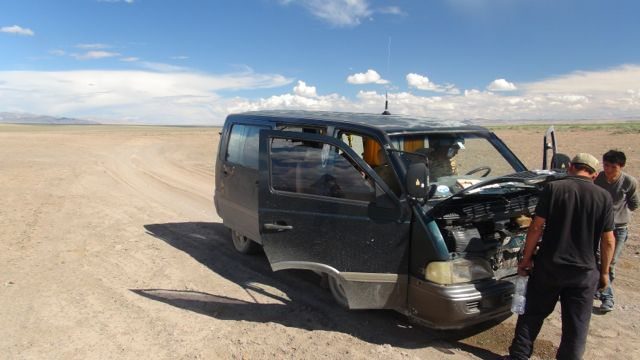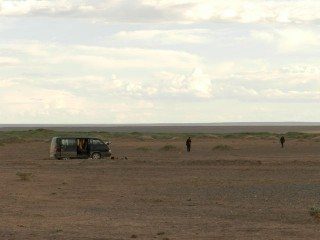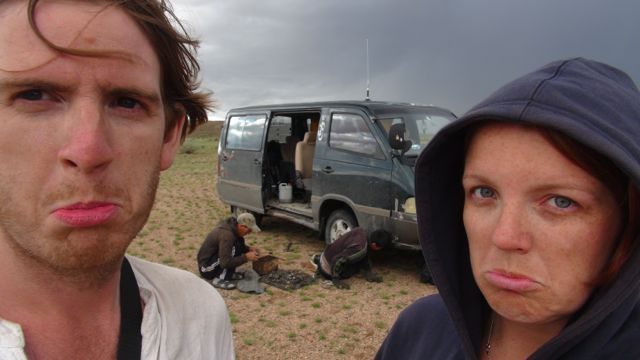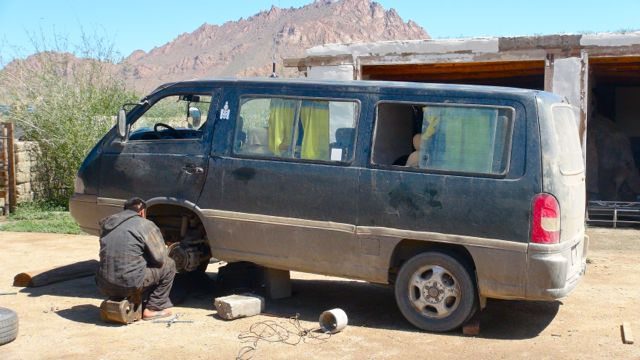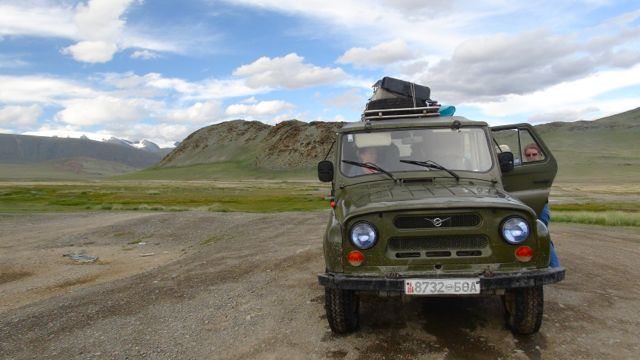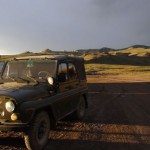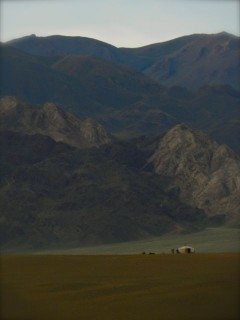 20 hours broken down and stuck in the Gobi Desert was not on our itinerary… and yet our dilapidated mini-van felt that it should be.
20 hours broken down and stuck in the Gobi Desert was not on our itinerary… and yet our dilapidated mini-van felt that it should be.
Actually our van – I named it “Turquoise Disaster” – had quite a few opinions about travel that were contrary to our own. Its propensity to fill the cabin with petrol fumes. Its willingness to open its own windows, allowing sand and dust to engulf us. Its decision to have the worst suspension in history, which made us feel as if we were riding bumper cars inside a giant washing machine.
Our trip across Mongolia was unconventional. We were not taking an organised tour the whole way, like 90% of travellers do. We were going entirely overland, not flying. Most importantly, it was a one way ticket.
We left the town of Moron (pronounced “moorun”) on the morning of the first day. We made it at least a few hours out of town before the troubles started…
Our drivers spoke no English. So when the Turquoise Disaster broke down for the third time, in a far more serious way than its previous attempts at failure, we had little understanding of what had happened – aside from the massive crunch that occurred immediately before grinding to a halt.
The van had already proven itself unreliable. Prior to its latest incarnation as a metal corpse in the middle of the Gobi Desert, we’d already had a number of “maintenance” stops.
For instance, our gearbox was shot. The drive team had engineered it into permanent 3rd gear. This meant quite a few run-ups when we approached hills and getting out to push when we needed to initially get the Turquoise Disaster moving. It wasn’t clear if we should be getting some sort of discount for the additional manual labour… We didn’t.
Previous stops had felt like par for the course, no reason for concern. This was Mongolia after all. Traversing the country off-road in a Chinese minivan is like trying to get to the moon using a paddle boat – difficult.
This breakdown was different. It was apparent, even to someone with as little knowledge of mechanics as myself, that the radiator had emptied its fluid contents all over the sand. As a paying customer, I felt dismayed that it had chosen to empty without any prior instruction from me. Unfortunately, like any employee working way too much unpaid overtime, I think it had just had enough and resigned.
It was 4pm. Let the Mongolian experts do their work and we’ll be moving again in no time, we thought. We noticed that they had no drinking water and only a bit of dry bread left, they obviously weren’t concerned that this lack of provisions would be a problem. A dry and dusty death in the desert was probably not on the cards.
It’s also obvious at this juncture that we didn’t die, well, at least I didn’t. This may somewhat ruin the suspense of the story, sorry. It’s also worth pointing out that Mongolia does not have the RAC, AA or any other form of breakdown recovery service that we’d been familiar with in countries with real roads.
It was customary for our drive team, every time we broke down, which was often, to get out the “Man box”. This is not some homo-erotic ritual, well, not exactly. It is in fact their massive box of bits: Nuts, bolts, wires, random scraps of metal.
It was essential for them to spread these all out on the floor, sift through them purposefully and then return them to the box. Maybe it was some sort of mental therapy, a physical method for thinking through the problem, a problem which was rarely solved with the contents of the man box.
A couple of hours passed with many man box sortings and various jacking ups and lowerings of the Turquoise Disaster. It seemed this time the problem was serious.
Pointing and gesturing they explained to me that the radiator and its intake were no longer in working order. This was easy to believe given the general state of the mechanics in front of me. Honestly, they could have said the entire van was scrap and I’d have believed them. Spit and sawdust may metaphorically be used to fix things. Their actual, physical use is not particularly effective and they had been overused in holding this piece of junk together…
Dis-heartened we contemplated getting our stuff and hitching a ride out of there. Then, the unmistakable sound of sticky tape. Yes, as if spit, sawdust and a man box of metal bits were not already insufficient for car repair, they’d moved on to sticky tape. I decided if it was time to Macgyver the van, I wanted to be involved.
Like the cavalry I valiantly arrived bearing duct tape – surely more effective than the sticky tape. They sealed up the Radiator intake and by about 8pm they were starting up the engine.
Had all my concerns been in vain? Could a van really be fixed using the Macgyver method? No. It couldn’t. We made it about 10 minutes before we had to pull over again.
The light was fading fast. The drive team had resigned themselves to giving up until tomorrow. With no convenience store in sight how would they survive the night? We became both cavalry and benefactors. Not content with some free duct tape, we were also guilted into contributing biscuits, jam, bread and water to the cause.
I’m from England, a country where the nearest town, or even pub, is rarely more than 5 minutes away. So I was surprised to see a group of 3 Mongolians being less prepared for the possibility of starvation and de-hydration than I was, on a trip across one of the harshest landscapes in the world.
Fed with biscuits and jam, the option of working through the night was out. It was time for us to enjoy some serious snoring from our local chums as the five of us bedded down for the night inside the Turquoise Disaster.
Something we came to learn about Mongolians is that they have the uncanny ability to sleep on demand. They jumped into the van at 9.30pm and insisted we sleep instantly. We were bemused. 9.30pm is long before our bedtime. We set up some bedding anyway and before even climbing inside my sleeping bag all 3 of them were snoring. This phenomenon has since been repeated, it’s not a comedy routine, it really happens.
Given past experience of these guys, and the fact we went to bed at 9.30pm, I expected the drive team to be up at the crack of dawn getting busy with the engine. They weren’t. In fact their very casual attitude to being stranded was becoming quite a concern – like a gazelle who gives up the second the first lion tooth pierces flesh. What was their plan? Did they have any more options?
They finally arose at 10am. The head driver proceeded to use almost a whole bottle of precious water to wash his hands and have a shave. Not the actions of a desperate man, I thought, but maybe of a man who has nothing left to lose. When they started working on the engine again it became clear why we had not made it very far after the first round of repairs. The radiator was not the only problem.
The big metal thing that sits under the engine containing the life giving oil had a hole the size of a biscuit in it. Back out came the man box of metal bits.
Finally Mongolian ingenuity shined through. The road we were stuck on was busy, for the Gobi Desert. Maybe one vehicle every 30 minutes. The drive team hailed down every passer by to acquire supplies, often relying on me, as benefactor, to front the money – another supply they had failed to bring.
Within an hour we had quite a collection: Radiator fluid, glue, tape, water. Then a convoy of 3 massive trucks arrived and we stocked up on engine oil. Using the amazing selection of metal from the man box, they bolted up the massive whole and coated the patch with “steel gel”. They refitted the mess of parts, and a few hours later – 20 hours total stranded – we were on the move. This time it would work, we thought.
The rest of the day passed uneventfully. We left the desert, got some food, passed a massive lake, a gleaming mirror of calm water. The guys went for a swim. It had turned into the sort of trans-Mongolian trip we’d been looking forward to: Epic scenery, open spaces. But this story my friends, is far from over.
By 7pm we were crossing a mountain pass. The weather rapidly turned, as it does in Mongolia – even during the summer! Freezing rain and winds.
We were only about 2 hours from our destination: Khovd. This is where the head driver’s family lives and he was clearly excited to get home. Reckless driving ensued. Mongolians call it “Chaein” apparently, as they comically informed us whilst blaming each other for the various breakdowns. Inevitably we hit a massive bump. The dream was over.
The patch they’d used to plug the oil tank had been ripped out and black gold was spewing forth all over the ground. Here we go again. Back up on the jack and about an hour of working in the rain later, they decided they had fixed it, again.
We limped down the mountain using the only working gear, 3rd, in a van mainly bound by gaffa tape and man box metal pieces. Somehow as the sun set on the 3rd day, we’d made it to Khovd – a soulless dust bowl of a dead end town.
Unsurprisingly, the morning brought the revelation that the van was not really up to another day of travel. No shit Sherlock. It wasn’t really in a state to travel from day one.
Our options were to wait in Khovd until the following day, or our driver would pay for a “Taxi” for us to leave that afternoon. It turned out the word “taxi” is not quite the same in Mongolia as in other countries. Unknowingly we assented to this plan.
Item of concern number one was that when the 5 seater jeep arrived there were already 5 people, including driver, in it. Over filling vehicles is common in Asia, two of the occupants were young teenagers so wouldn’t take up too much room, we figured, maybe some people would get out along the way… This was an idiotic thought process on our part. Of course people wouldn’t get out along the way… More people would get in.
By the time we left Khovd our 5 seater jeep contained 10 persons – including a pregnant woman, an ageing Shaman and a 1 year old baby (So, nine and a half people plus a fetus) including of course, two “much larger than Asian people” westerners. Luggage was moved from the trunk to the roof so that the two teenagers could sit in it. The old Shaman was moved from the passenger seat to the back seat to give way for the preggers chick and her current one year old. he was not happy about this. One guy was sat over the gearbox, and the rest of us were squashed on the back seat with the Shaman.
Could it get worse? Of course! The 5-6 hour journey turned into almost 8 hours with possibly the most careful driver in Mongolia painstakingly taking his time.
We finally arrived in Olgii well after dark.
I love adventure travel but sometimes I wonder “why not fly”? In total this journey cost us 200,000MNT (about $150US) per person and took 4 days. More than the locals would pay but still a decent price for Westerners. Flying would have cost a little more and taken a day.
But this was the real Mongolia. Enjoyable is the wrong word, genuine and character building is the best way to look back at these events.
I may not have loved the stress or being thrown around, squashed and stranded but this is how Mongolians travel.
Now I have a much closer understanding of what life is really like for the locals.
————————–
This was part 3 of our trans-Mongolian trip. Find out what happens next or how we got this far in Part 1 (Zamiin-Uud to Ulaanbaatar), Part 2 (Ulaanbaatar to Moron) or Part 4 (Olgii to The Bulgan Border and China)
If you’ll be travelling to Mongolia you should also check out our 9 tips for surviving Mongolia article/video
————————–

